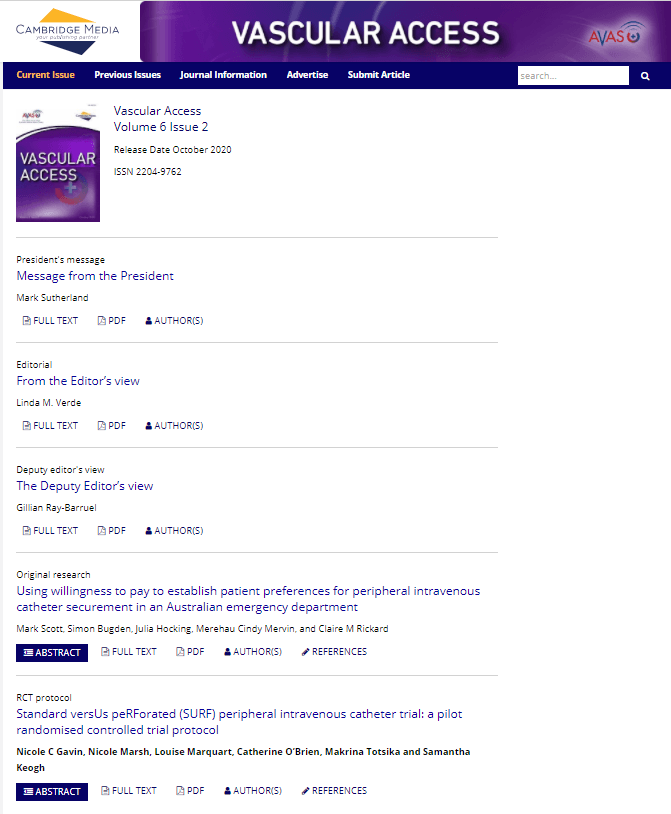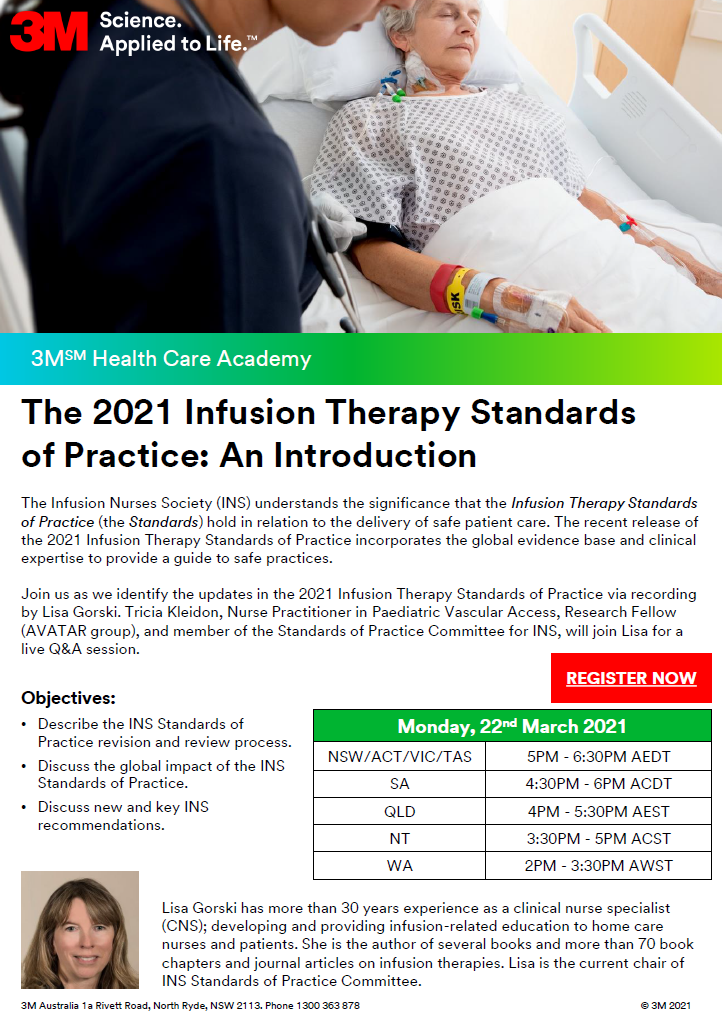3M Health Care Academy - The 2021 INS Infusion Therapy Standards of Practice: An Introduction
Posted
on 17 March 2021
| Posted in:educationIV managementIV therapyvascular access devicesguidelinesevidence-based practice |
A vascular access minimum dataset
Posted by Jess Schults
on 10 February 2021
)
Check out our recent work to develop international recommendations for VA data capture
..including standardized catheter definitions and a top 10 list for when you can't collect all the data you'd like.
Quality data to monitor VA safety is rarely available at the hospital level. This makes it hard to benchmark practices within your hospital, nationally and with your international neighbors.
"Perhaps the "problem" is that the current quality indicators for vascul...
| Posted in:clinical quality regsitryminimum datasetpatient safetyvascular access devices |
Call for Papers!
Posted by Gillian Ray-Barruel
on 7 December 2020
)
Vascular Access Call for papers
THE DEADLINE FOR SUBMISSIONS FOR THE APRIL 2021 ISSUE IS 22 JANUARY 2021
The Australian Vascular Access Society (AVAS) is an association of healthcare professionals founded to promote the vascular access specialty (http://avas.org.au/). Our multidisciplinary membership strives to advance vascular access research, promotes professional and public education to shape practice and enhance patient outcomes, and partners with industry to develop evidence-base...
| Posted in:vascular access devices |
Confessions from a PhD student, what I wish I knew when I started
Posted by Jessica Schults
on 25 November 2020
)
How do you make it through one of the most intense degrees of your life whilst juggling family, friends and work? For me it was sheer stubbornness, but we asked some trusted colleagues who have recently completed their higher degree research training or are in the midst of completing.
Reflections from Grace, Nancy and Evan
For you,
Take time out to do other hobbies and completely forget about your project even for a day a week
Help family understand there will b...
| Posted in:higher degree researchAVATAReducationvascular access devices |
Be sure to secure VADs when patient access is limited: 3M webinar now available
Posted by Nicole Marsh
on 9 November 2020
Proper VAD securement saves time, money, resources, and patient veins. It also helps prevent phlebitis and bloodstream infection.
This is a webinar developed by 3M and Dr Nicole Marsh to highlight many of the key considerations surrounding vascular access device management during Covid-19.
You are welcome to share with your staff, if this is useful.
https://mmm.bravais.com/s/a9Xs7NL8TEyBl629slx5
...
| Posted in:dressingssecurementvascular access devices |
Vascular Access October issue out now!
Posted by Gillian Ray-Barruel
on 2 November 2020
)
VASCULAR ACCESS, October edition of the peer-reviewed multidisciplinary official journal of the Australian Vascular Access Society (AVAS) is now available. To access this journal, you must be a member of AVAS.
Becoming a member is simple. Apply today!
| Posted in:vascular access devices |
What's best practice to maintain cannula patency?
Posted by Gillian Ray-Barruel
on 27 October 2020
Have you ever wondered what's best practice for maintaining IV patency?
This video reveals the science behind the practice.
We've updated our FAQ to help you deliver the best care when your patient needs to keep the vein open (kvo) via slow continuous infusion or intermittent flushing.
To find out more about slow continous infusion (kvo), click here.
To find out more about intermittent flushing, click here.
...
| Posted in:peripheral intravenous catheterpatencykeep vein openkvocannulaflushingintravenous catheter |
19 things I wish my research student knew
Posted by Jessica Schults
on 12 October 2020
Thinking of undertaking research studies, we asked 3 experienced supervisors what they wish their students knew:
By Dr Gillian Ray-Barruel:
A PhD is about the learning process, not just the finished product.
Be an active student member of your university community. Networking is invaluable for your career and you'll make some interesting new friends.
Go to all the free HDR student education sessions offered by your university. You may/may not learn something useful a...
| Posted in:higher degree researchAVATAReducation |









